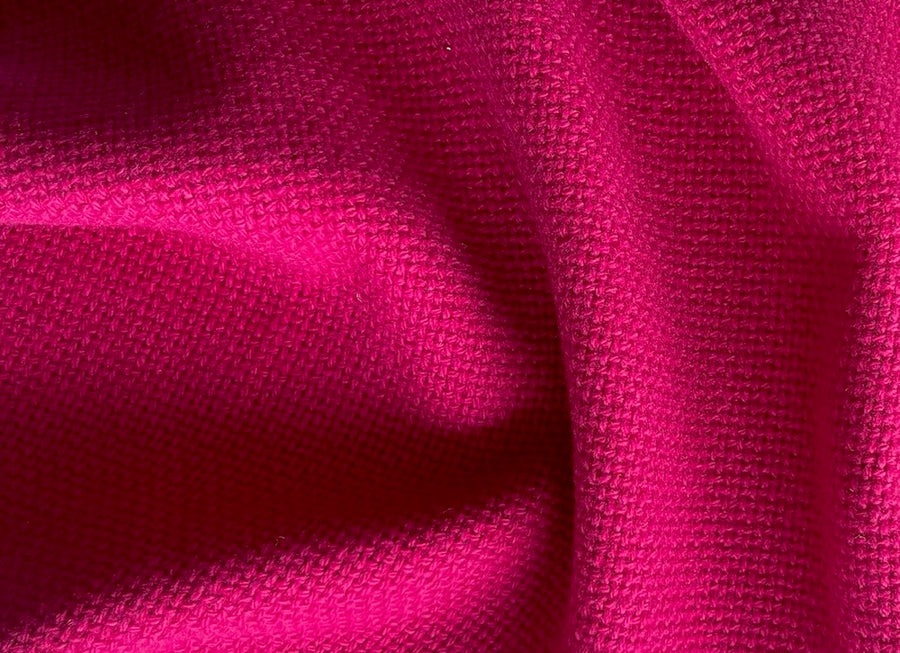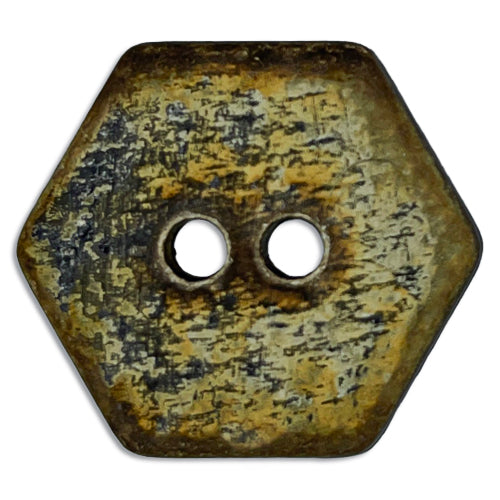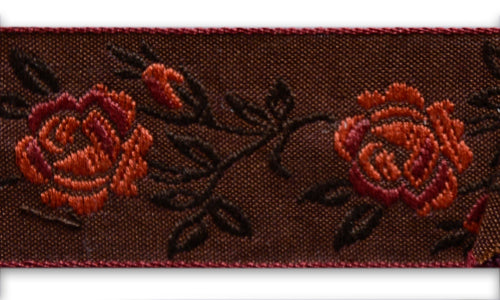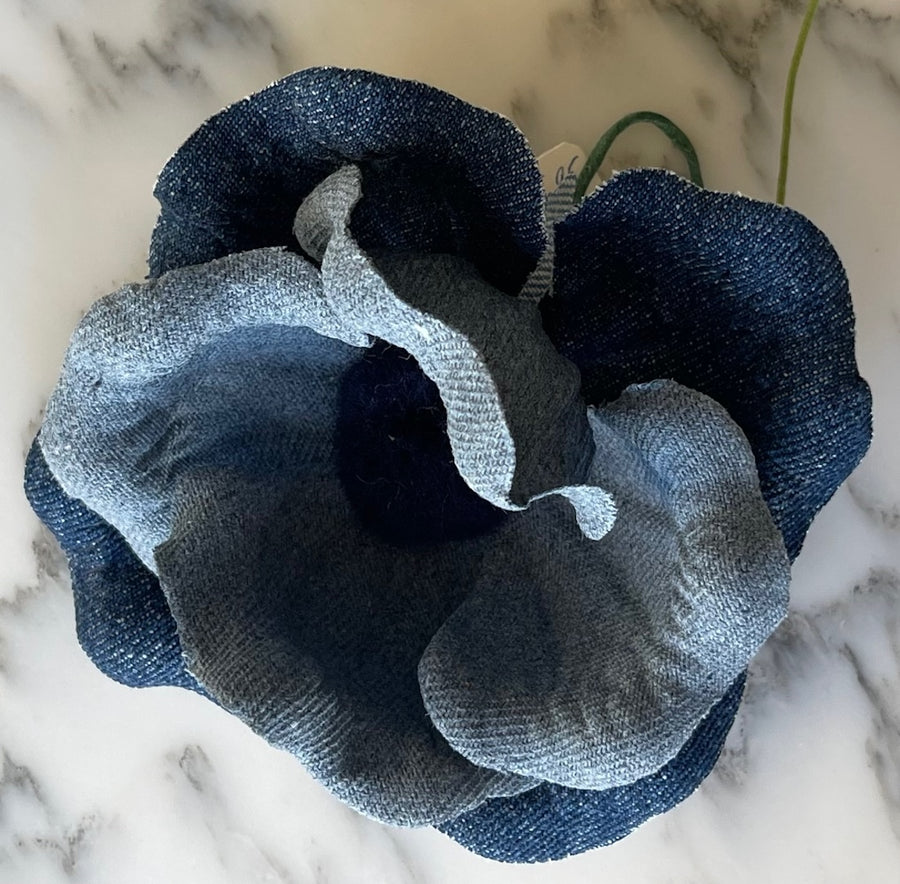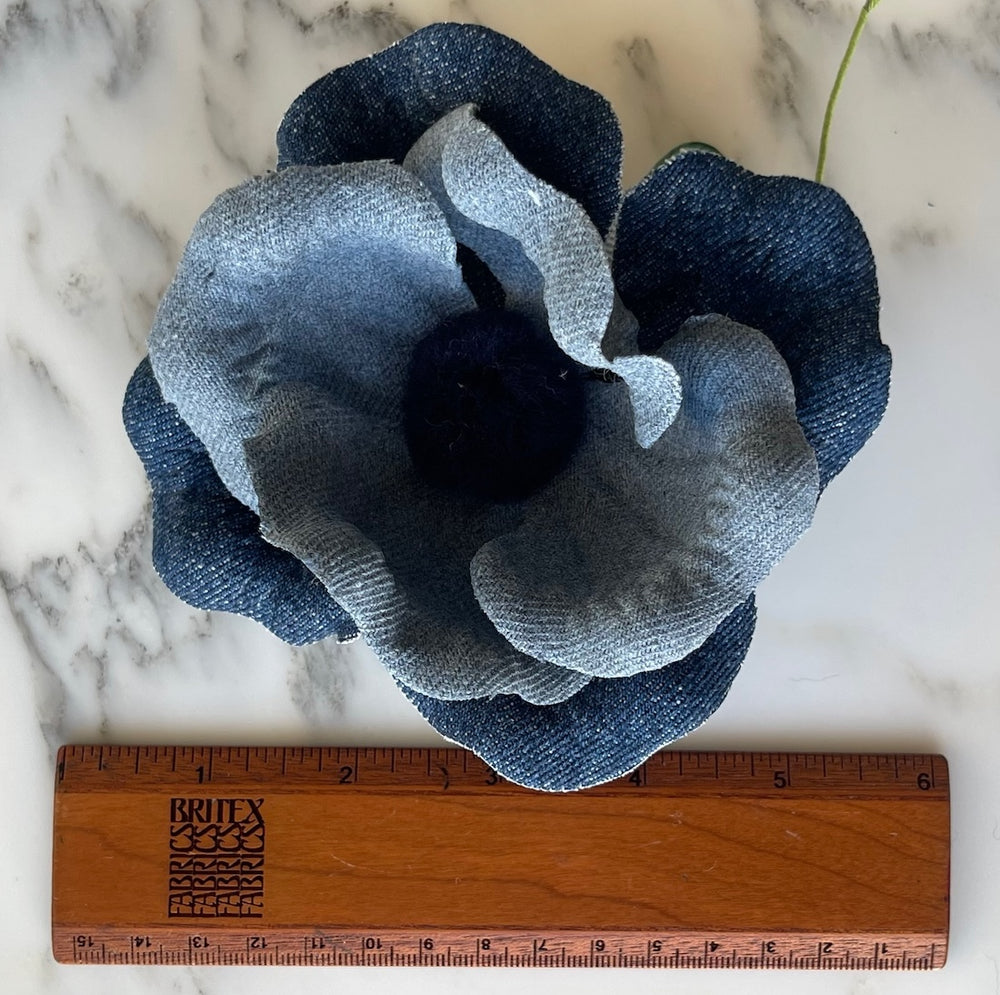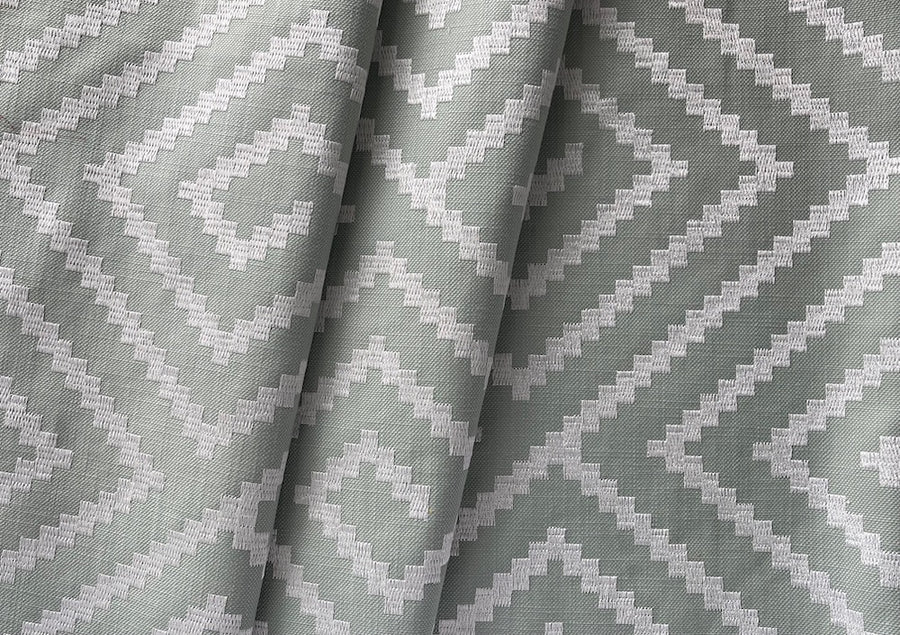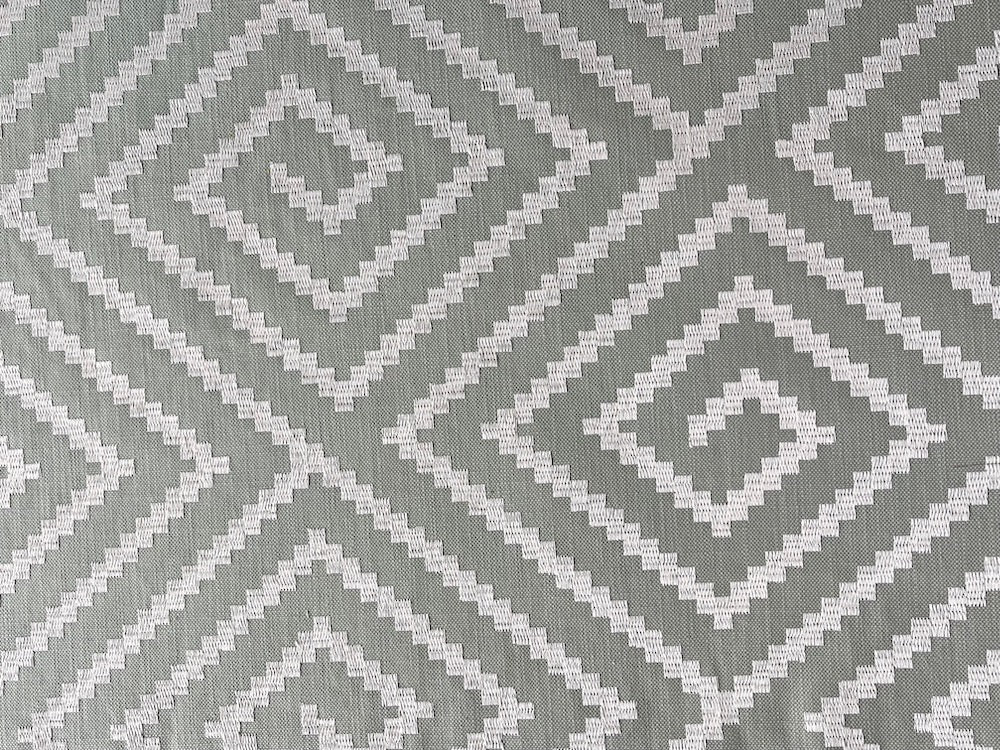|A | B | C | D | E | F |G |H |I | J |K | L | M | N | O |P |Q | R | S | T |U | V | W | X | Y | Z |
A
Acetate
Man-made fiber composed of cellulose acetate, a substance chemically derived from plant fiber (cellulose). Acetate fabric has excellent drape; it is most often woven as crepe or satin.
Alpaca
Domestic member of the camel family, closely related to the llama. Its fleece is fine, soft and elastic with some lustre, and is generally used by itself or blended with wool for soft coatings.
Alencon
A needlepoint lace with a fine net or tulle ground, with a pattern outlined in satin cording. Also called re-embroidered lace.
Antique Satin
Reversible fabric that is satin on one side and slubby (like shantung) on the other. Generally seen in vintage fashions and draperies.
B
Basket Weave
A variation on the plain weave, which results in a comparatively loose construction and a visible basket-like appearance.
Batiste
A soft, lightweight woven cotton, heavier than voile and very slightly lighter than lawn. Batistes are mercerized to produce a subtle sheen or lustre, and often woven with a satin face to enhance this effect.
Bemberg Lining
Soft, supple rayon lining designed specifically to be easy-care and durable. Rayon Bemberg is the recommended lining for virtually any garment.
Bengaline
A faille fabric with small to medium-sized ribs running from selvedge to selvedge. Bengaline can be made of virtually any fabric but is seen most frequently in silk, silk-like blends, and cotton.
Bias
The diagonal grain of the fabric. Cutting fabric on the bias will provide elasticity and create garments that conform to the wearer’s body shape.
Body
The inherent drape, weight and texture of a fabric. A fabric with stiff body (like a taffeta) will make architectural styles, while a fabric with soft body will drape and fall.
Boiled Wool
Boiled wool is created by boiling and agitating the fabric in hot water and soap. The scaled surface of the wool fibers stick together and ‘felt’ into a tight, dense material that is durable, water resistant and non-fraying. Boiled wool can shrink up to 50% in all directions during this process.
Border Print
Also called an Engineered Print, border prints have a pattern that runs from selvedge to selvedge, with more density or complexity on one side than the other. These fabrics are clearly directional, with one side intended for use at the hem.
Boucle
A woven or knit fabric made with curly (boucle) yarns, which are often looped or knotted. Boucles can be made of virtually any fabric or blend, and are universally recognizable in “Chanel” jackets.
Broadcloth
Originally, fabric made on a wide loom. Broadcloth is a traditional medium-weight shirting, similar in weave but lighter than poplin, generally made of fine cotton but occasionally blended with polyester.
Brocade
Jacquard fabric with a raised pattern, often woven or re-embroidered with metallic threads.
Burn-Out
The process of chemically stamping patterns on a fabric that is made of both natural and synthetic fibers, most frequently used on velvets. In this process the cellulose in the pile is burned away, leaving the stronger synthetic base fibers behind.
C
Camel Hair
An all-wool fiber, derived from the hair of an Asian camel crossbred from dromedary (one hump) and bactrian (two hump) camels. The resulting hairs are both heat and cold resistant. Fibers from the top of the animal are generally coarse and sturdy, while fibers from the thick, soft undercoat are airy, soft and luminous.
Canvas
A sturdy plain weave cotton fabric. “Canvas” and “duck” are used interchangeably, but canvas tends to be the heavier of the two fabrics.
Cashmere
Wool from the fine, downy undercoat of the cashmere goat. Cashmere makes excellent coating and throws and is also frequently blended with sheep’s wool.
Challis
A soft, supple plain weave fabric generally made of wool, rayon/viscose or a blend of both. Challis makes excellent skirts, dresses and pashmina-style shawls.
Chambray
Originally woven in Cambrai, France, chambray is a plain weave, yarn dyed fabric with white warp threads and colored fill threads (most frequently blue), traditionally made of cotton but occasionally of rayon or synthetic blends. Chambrays can be either sportswear or shirting quality; the latter is also called dress or fancy chambray.
Chantilly
Originally produced in Chantilly, France, this is a fine, delicate, bobbin lace with a fine net ground, without heavy cording or re-embroidery.
Charmeuse
Lightweight, soft fabric with a semi-lustrous satin face. It can be made of silk, rayon, polyester or blends, and has excellent drape for dresses, blouses and lingerie.
Chenille
Derived from the French for ‘caterpillar’, fuzzy chenille yarns have pile protruding from all sides. Generally these yarns are used as fill with a sturdier warp yarn. Chenille can be used for upholstery, bedspreads, coats and even rugs.
Chiffon
Lightweight, sheer fabric with excellent drape, made with a plain weave. Chiffon can be made of silk, rayon, polyester or a blend.
Cordura
Trademarked by DuPont, Cordura is an extremely durable, industrial weight nylon fabric.
Corduroy
A durable fabric, traditionally made of cotton but occasionally of synthetic fibers and blends, with a twill back and vertical cut-pile stripes on the face. The stripes, called ‘wales’, can be of varying width from pinwale to wide wale.
Corozo Nut
Also called Tagua nut or vegetable ivory, Corozo comes from ivory palms, which are so named because the nut fiber’s material is similar in consistency and appearance to ivory.
Cotton
A durable, breathable fabric constructed from vegetable seed fiber (the boll of the cotton plant). The plant itself is often used as the cellulose base for some rayons.
Coutil
A strong, heavy cotton or cotton/rayon fabric used for stability in corsets and structured tailoring.
Crepe
Soft, drapey fabric made of twisted yarns that create its distinctive texture. Crepe can be made of silk, wool, rayon, synthetic fibers, or blends.
Crepe de Chine
A fine, lightweight plain weave silk. Used for dresses, blouses and linings.
Crossgrain
The fabric grain running from selvedge to selvedge, instead of up and down. Many fabrics behave differently when they are cut on the crossgrain instead of the straight.
D
Denim
A medium- to heavy-weight twill fabric, generally made of cotton but occasionally produced from linen, wool, viscose, or blends. Denim is highly durable and originally designed for sailors’ work clothes.
Digitized Print
Digital printing makes it easy to print gradations, complex color palettes, and digital collage style prints that were difficult or impossible to achieve with traditional screen printing methods. Digital prints are recognizable not only for this complexity on the face, but for tell-tale lack of color on the back of the fabric. Because the cloth is only passed a single time through the printer, it does not get as saturated as it does from multiple screens.
Dobby
Dobby is a woven fabric produced on the dobby loom, characterized by extra texture or small textured patterns in the finished cloth.
Dotted Swiss
A sheer plain weave cotton (batiste or lawn) with small raised dots in a regular pattern.
Doubleface
Fabric that is fused or woven to have a finished face on both sides. In contrast, reversible fabrics are not fused, but are simply woven to be usable on both sides.
Doubleknit
Heavier than single-knit fabrics, doubleknits are knitted with two sets of needles on a circular machine. Both sides of the fabric are usable.
Drape
The way a fabric falls and folds around the body. A ‘drapey’ fabric has soft body,i.e. little to no stiffness.
Duck
General term for strong, firm plain weave fabrics, usually cotton. Canvas is one of the heavier duck cloths.
Duchess Satin
Often called ‘bridal satin’ or ‘peau de soie’ (‘skin of silk’), duchess is a medium-weight satin with soft, pearl-like lustre on the face. It has good body and a relatively stiff hand, comparable to that of faille.
Dupioni
Silk produced by using fine thread in the warp and thread reeled from two or more entangled cocoons in the weft. It is similar to shantung but slightly thicker, heavier, and with a greater slub (cross-wise irregularity) count. Dupioni is highly lustrous, with a crisp hand comparable to taffeta.
Duvetyn
A twill-back velveteen with a soft nap, pliable and similar in appearance to suedecloth or moleskin. Duvetyn is frequently treated for fire resistance and used in theatrical applications.
E
Elastic
A fabric or trim that can elongate (stretch) when tension is applied, and recover to its original length and shape when tension is released. Some materials have inherent elasticity, while others rely on a core yarn of Lycra, Elastane, or natural or synthetic rubber.
Eyelet
1. A fabric with cut-out areas or figures with stitching around them, generally with additional embroidery throughout the design. First produced in Switzerland and traditionally made from fine cotton. 2. A small metal grommet.
F
Faille
A flat-ribbed fabric made of silk, cotton, viscose, poly or blends, with good body similar to that of duchess satin. Ribs can be narrow enough to be almost invisible, medium width (bengaline), or wide (ottoman). Faille trims are also called grosgrain.
Flannel
A shirt- or suit-weight wool or cotton with a plain or twill weave and slightly napped surface.
Flax
The oldest textile fiber known, flax is the base for most linens. The 12” – 40” soft fibers are obtained from the plant’s stalks and subdivided, and then are woven into yarn.
Frog
Frog closures are decorative closures frequently made of silk or rayon, which typically feature a braided or looped design.
G
Gabardine
A tightly woven cotton, wool or polyester suit-weight fabric with a distinct twill weave.
Georgette
A sheer, lightweight fabric with a fine crepe weave, slightly more opaque than chiffon. Georgette is generally made of silk, viscose, polyester, or blends.
Grosgrain
A faille (ribbed) ribbon or trim. Grosgrain can be made out of polyester, cotton, silk, rayon or blends. Rayon grosgrain is called ‘Petersham’ and is often used in hatbands, waistbands and dressmaking projects, because it can form a curve when steamed.
Guipure
A lace without a mesh ground, with the pattern held together by connecting threads. Also known as Venise lace, Guipure is generally made of rayon, polyester, or blends and is manufactured in both trim and yardage widths. The connecting threads around designs can be easily cut to produce appliqués.
H
Habutai
Soft, plain weave silk fabric, comparable to or slightly lighter in weight than crepe de chine.
Hemp
A coarse, strong fabric obtained from the inner bark of the cannabis plant. Hemp withstands the rotting action of water better than other materials and thus has traditionally been used for twine, cording, and riggings for ships. Hemp material is similar to linen in its hand and lustre.
Herringbone
A broken twill weave composed of vertical sections which are alternately right hand and left hand in direction, forming a series of chevrons or Vs. Herringbone is one of the most popular twill weaves and is most frequently seen in suit- or coat-weight wools.
Houndstooth
A pointed check pattern produced by a two up, two down broken twill with four ends and four picks in each repeat. Houndstooth is one of the most popular suit and coat patterns; small-scale houndstooths are often called ‘puppytooth’.
I
Ikat
Ikat fabrics are made from yarn that has been tied for dyeing and weaving, as opposed to tying the whole fabric. This technique produces a streaked geometric pattern that is a common element in many textile traditions worldwide.
Iridescent
Also called crosswoven, iridescent fabrics have changeable color or shot effects. This effect is most often produced by using different color yarns in warp and weft, but can also be achieved with dyes or finishing.
J
Jacquard
Patterned fabric woven on a Jacquard loom, with the back side of the fabric being a negative in color and texture of the face. Tapestry, brocade, and damasks are jacquard fabrics.
Jersey Knit
Plain-knitted fabric with no distinct rib. Jersey can be made of wool, silk, cotton, rayon, polyester, or blends.
K
Knit
A fabric constructed by interlocking a series of loops by hand or by machine, as opposed to being woven on a loom. Knits come in virtually every weight, from tissue knit to heavy ponte, and can be made from virtually every fiber.
L
Lace
A decorative, highly detailed fabric formed without a ground fabric (as opposed to embroidered tulle). Lace features irregular mesh and detailed floral or geometric patterns, and can be created by hand with bobbins and pins, needles, or hooks, or by machine.
Lawn
A fine, plain weave cotton that is relatively lightweight, with more body than voile and less body than Pima. Liberty lawns are denser than most lawns, and are excellent for shirts and dresses.
Liberty of London
Launched in 1875 by Arthur Lasenby Liberty, this department store featured luxury goods from all over the world. Its famous Liberty Tana Lawn (named after Lake Tana in Ethiopia) is one of the most popular fabrics in the world, featuring many screenprinted patterns designed by William Morris during the Art Nouveau era, plus a wide assortment of new digitally printed designs.
Linen
Very strong, durable fabric, either woven or knitted, made from flax fiber. Linen breathes well , has excellent, bouncy body, and is easily wrinkled. Linen can as lightweight as a drapery sheer, or heavier than canvas.
Lycra
A trademark of DuPont for its spandex fiber, Lycra is a strong elastic with a greater flex life than conventional elastic threads.
M
Melton
A plain-woven coating that is so tightly constructed that the warp and weft are invisible and the face is completely smooth. Melton is frequently made into overcoats and uniforms.
Mesh
A woven or knit fabric with open spaces between the yarns. Mesh is pliable and possesses good elasticity, especially when it is woven with Lycra.
Mohair
Fabric made from or blended with yarn made from the long, lustrous hairs of the angora goat. Mohair coating has excellent loft and texture; 100% mohair coating tends to be extremely lightweight and pliable. By contrast, the fibers in mohair upholstery are densely woven and clipped very short, giving it a stiff, springy texture.
Moiré
Producing a “watered” rippling effect, moiré is a finishing process that uses engraved rollers to press the design into silk, rayon, acetate, or blended fabrics (most frequently failles). This design is only permanent on acetate fabrics: otherwise it will disappear when washed.
Muslin
Firm, plain weave cotton fabric, generally unbleached and unfinished. Muslin is the fabric of choice when patternmaking, draping, or creating sample garments.
Mikado
Heavy, lustrous silk or silk blend with a twill weave and a stiff but flexible hand. A favorite for bridal gowns.
N
Nap
The fuzzy surface of the fabric’s face. This fuzz can be raised evenly as in a velvet, smoothly as in satin, or in ribs or stripes as in corduroy. Nap produces a directional effect, meaning that the fabric will be a slightly different color and texture when turned 180 degrees.
Noile
Also called raw silk, noile is an extremely slubby, medium-weight silk with more drape and less lustre than dupioni or shantung.
O
Organdy
A fine, sheer, organza-weight cotton fabric, which is finished to give it an extremely stiff hand. This finish is traditionally achieved by partly dissolving the cotton and allowing it to reharden, and more recently by applying a chemical treatment with a cellulose finish.
Organza
A thin, sheer fabric made of silk, polyester, rayon or blends, made in a plain weave and finished to have a crisp, stiff hand.
Oxford
A traditional shirting (generally made of cotton) woven with a modified basket or plain weave to have a distinctive “pinpoint” texture.
P
Pacific Cloth
Also called “silver cloth,” Pacific Cloth is specifically designed to keep silver from tarnishing.
Peau de soie
Translated literally from the French as “skin of silk”, peau de soie is a medium-weight, matte (low sheen) satin with good body, also called duchess satin or bridal satin.
Petersham
A rayon faille trim used both decoratively and in dressmaking, as waistbands, hatbands, or any application that requires a curved tape or binding.
Pile
Raised loops (cut or uncut) that form all or part of the surface of a fabric, which often results in a plush texture and hand. When crushed or creased (deliberately or accidentally), the pile looks lighter in color.
Polyester
A man-made fabric in which the fibers are formed from specific long-chain synthetic polymers. Many polyesters are now made of recycled materials, including plastic bags. Polyesters do not wrinkle, and thus they travel and wash well.
Poplin
A dense, crisp shirting with an architectural hand, akin to high-quality sheeting.
Q
Qiana
No longer in production, Qiana is a lightweight nylon fabric with excellent drape, sheen, and wrinkle resistance, patented by DuPont and featured in many quality vintage garments.
Quilted
Two plies (thicknesses) of fabric, generally filled with cotton or synthetic batting and stitched through in diagonal lines or decorative patterns.
R
Rayon
The generic name for man-made fibers that are synthetically manufactured from cellulose, which is generally sourced from trees or from the cotton plant once the bolls have been removed to make cotton. Despite being man-made, rayon retains the properties of a natural fiber, including excellent breathability. Viscose, fibranne, bamboo rayon, and other cellulose-based fibers are made from the rayon process.
Repeat
The entirety of a pattern from top to bottom, which is repeated over and over throughout the yardage. Repeat must be considered when estimating how much yardage is necessary for a project, in order to place the pattern correctly.
Reversible
A fabric woven to be used on either side. The design, texture, or color is different on each side.
S
Satin
A fabric made with a satin weave (lustrous on one side and matte on the other). Satins can be made of silk, polyester, viscose, or blends, and can be extremely pliable (as in crepe satin) or somewhat crisp (duchess satin.
Sateen
A cotton fabric woven with a satin weave. Sateens have moderate lustre on the face, and are generally sturdier than other satins. Sateens are distinguished from mercerized cottons and chinzes because the sheen comes from the weave, and not from a finishing process.
Silk
Silk is a protein filament secreted as fluid by the Bombyx mori caterpillar when constructing its cocoon. These filaments are extremely strong and lustrous and can be woven into slub silk (dupioni, shantung, noile), or finely textured silk (chiffon, duchess satin, charmeuse, 4- or 6-ply crepe, and more). While all silkworms eat mulberry leaves, particular strains of mulberry mash and particular types of silkworms will produce slightly different types of silk.
Slub
In silk, irregular thickenings in the filaments that result in a tufted, textured fabric (shantung, dupioni, noile). Slubs are often the result of two silkworms that develop an affinity and spin in concert, so that one filament cannot be separated from another.
T
Taffeta
A smooth, plain weave fabric with a crisp, architectural hand. Generally made of silk, rayon, acetate, polyester, or blends, taffeta has historically been considered a luxury fabric and used for stiffly ruffled garments, full skirts, draperies, and bedspreads.
Tropical Wool
A very light, finely carded wool, frequently suiting weight, that is easy to wear in very hot climates. Tropical wool is comparable to other natural fibers in its breathability.
Tweed
Textured wool or blended fabric with a distinctive and/or slightly hairy texture. Tweeds are traditional suitings and come in solid and heathered colors, checks, herringbones, plaids, houndstooths and more.
Twill
One of the most recognizable weaves, twill is distinguished by its visible diagonal ribs across the face of the fabric, as seen in gabardine or denim. This construction makes the fabric strong, durable and firm.
U
Underlining
Typically used in couture, underlining gives additional structure to a garment or portions of a garment. Generally made of silk organza, it is placed between the top fabric and the lining.
V
Velvet
A fabric with short, closely-woven cut pile, which gives the fabric a rich, plush texture. Velvet can be made of virtually any fiber, including cotton, rayon, silk, polyester, acetate, or blends.
Velveteen
Always made of cotton or cotton blends, velveteen has a velvet-like appearance with a twill or plain back. Velveteen is not, in fact, cotton velvet: it is more accurate to say that it is a no-wale, smooth corduroy. There are many differences in the manufacture of velvet vs. velveteen, the most basic of which is that velvet has a warp pile, while velveteen has a filling pile.
Viscose
One of three types of rayon, produced by chemically breaking down wood pulp or cotton linters to form a viscose solution, which is filtered and extruded through a spinneret. Viscose is man-made, but it retains the properties of its natural cellulose base fiber, including excellent breathability.
W
Warp
The set of yarn on a loom running lengthwise, parallel to the selvedge. The warp yarns are often stronger than weft or fill yarns, in order to give the fabric more stability.
Waxed cloth
A fabric treated with wax or paraffin. Many waxed fabrics are water-resistant, while others simply have added sheen and structure.
Weft
Also called filling, the weft is the set of yarn running from selvage to selvage, at right angles to the warp.
Wool
Fiber made from the fleece of sheep or lamb, or hair of the camel, alpaca, vicuna, or goat (cashmere or angora). Wool can be woven, knitted or felted into fabrics as sheer as gauze or as dense as 3mm felt. The finest suitings and tweeds are made of wool.
Y
Yarn
A continuous strand of textile fibers, either spun from shorter fibers or in one continuous filament. Yarn is woven or knit into various fabrics; spun yarns become cotton, wool, silk, linen, hemp, etc., while filament yarns are forms of rayon, acetate, nylon, and other synthetic textiles.
Yarn Dyes
Fabrics woven or knitted with yarns that have been dyed, as opposed to fabrics that are dyed as a piece, after being knitted or woven.




